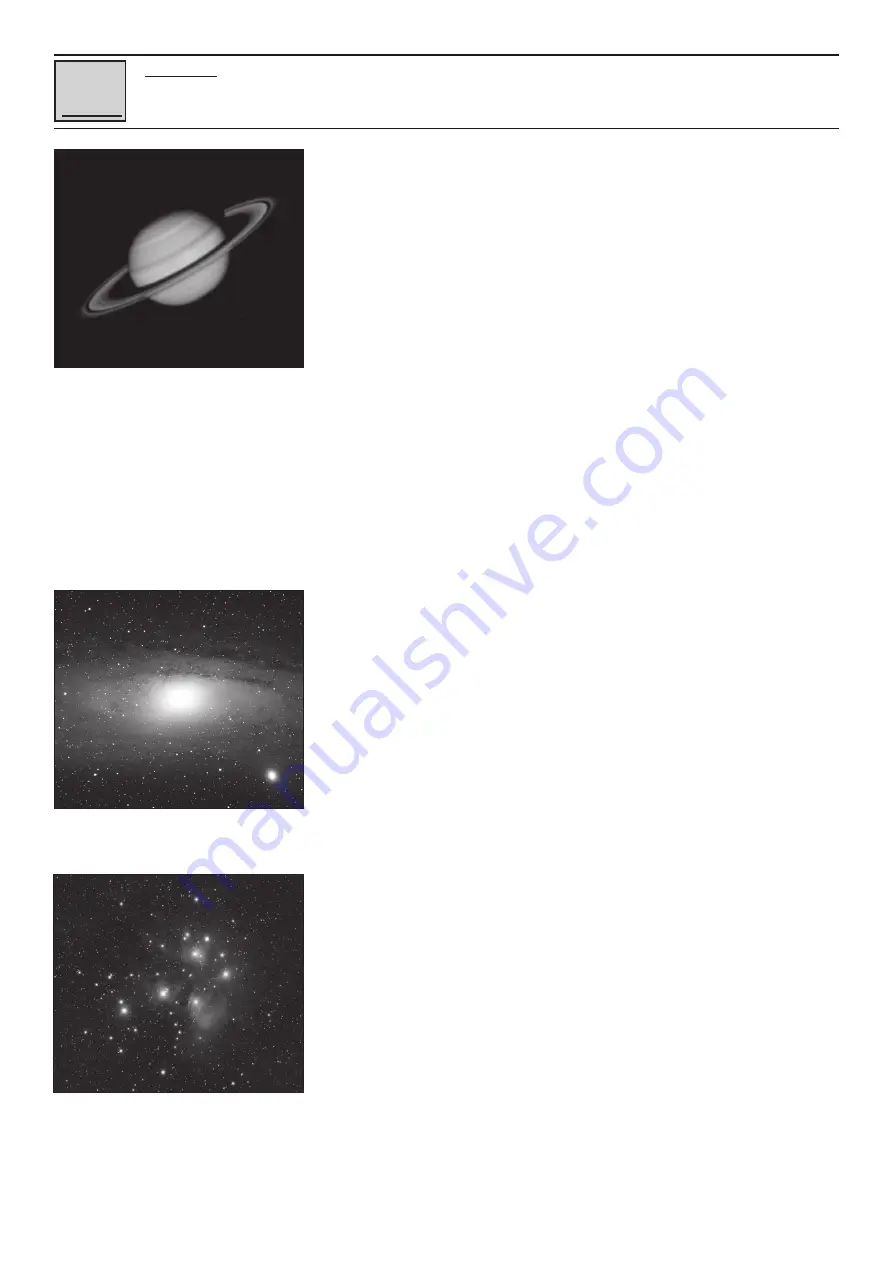
- 34 -
ring division within Saturn's rings, the so-called "Cassini division", can normally be seen
in the telescope. Titan, the largest of Saturn's 62 moons, is also visible as a bright, star-
shaped object not far from the planet. Under good visibility conditions, up to 6 Saturn
moons can be observed in the telescope.
Deep sky objects
In order to find constellations, single stars or "deep sky objects", the use of a star chart is
recommended. In the following, various examples of deep sky objects are listed:
The stars are huge gaseous objects that glow independently because they generate
energy in their centre through nuclear fusion. Due to their enormous distance, all stars
appear as needle-sharp points of light, regardless of the size of the telescope used.
The nebulae are extended interstellar gas clouds and dust clouds from which new stars
are formed. The most impressive nebula is without question the Great Orion Nebula, a
diffuse nebula that looks like a faint, fibrous, grey cloud. M42 is 1600 light-years away
from Earth.
An open star cluster consists of a loose group of younger stars, all of which have only
recently emerged from a single diffuse nebula. The Pleiades form an open star cluster
at a distance of 410 light years. Several hundred stars can be observed in the telescope.
Constellations are two-dimensional, imaginary star patterns which ancient civilizations
believed to be heavenly equivalents of objects, animals, humans or gods. These groups
of stars are far too large to be seen in their entirety in a telescope. If you want to learn
the constellations, start with a distinctive group of stars - for example, the Great Dipper
in the constellation of the Great Bear. You will then use a star chart to help you decipher
the other constellations.
The galaxies are gigantic clusters of stars, nebulae, and star clusters, all held together by
their mutual gravity. They are mostly spirally shaped (this also applies to our Milky Way), but
many galaxies can also look like elliptical or irregular light spots. The Andromeda galaxy
(M31) is the closest spiral galaxy to us. The sight of this Milky Way system resembles
that of a blurred fog spindle. At a distance of 2.2 million light years they are found in the
constellation Andromeda. It stands halfway between the big "W" of Cassiopeia and the
star square of Pegasus.
With increasing observation experience, you can also dedicate yourself to more
sophisticated observation objects such as globular clusters, planetary nebulae or comets
that appear from time to time.
The more objects you "spy", the more you will be able to estimate the observation
conditions and determine which objects are worthwhile in this night. It also makes sense
to record the observed objects and the viewing conditions in a notebook.
One of the best ways to capture what you have seen is by drawing. At the same time the
sense for details and fine nuances is sharpened here. Many of the professional journals
and internet forums for astronomy offer opportunities to exchange information with
other amateur astronomers.
Internet resources such as www.astrotreff.de or www.vds-astro.de are well suited to
deepening one's own knowledge and gaining new ideas. You will notice that as your
experience increases, so does your enjoyment of your hobby!
Appendix
VIII
Saturn is one of the most worthwhile objects of
observation, at least within the solar system.
M31, the Andromeda galaxy, is one of the easiest
objects to find and observe on winter evenings.
The Pleiades are probably the most impressive open
star cluster in the northern sky.
Summary of Contents for MCX Goto Series
Page 30: ...30 Computerised Handset with LED display VII Fig 35...
Page 39: ...39...





















